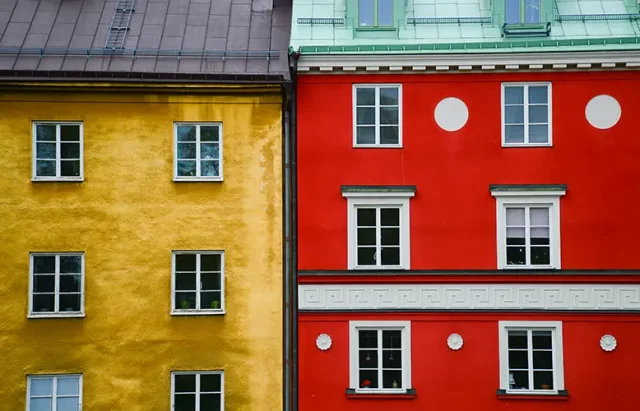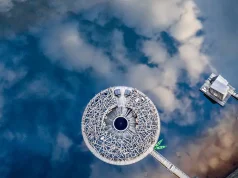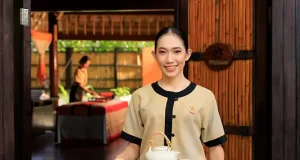
The ferry to Ærø leaves from Svendborg, crossing a calm stretch of sea scattered with small islands. The journey takes less than an hour, but it feels longer, as if time slows the moment the mainland fades behind you. The air smells of salt and wood, and the sea changes color every few minutes — blue, green, then silver.
As the ferry approaches the harbor of Ærøskøbing, the town appears like a watercolor. Small houses line the waterfront, their façades painted in soft pastels: ochre, pale blue, faded pink, cream. The streets rise gently from the harbor, cobbled and narrow, framed by low walls and hollyhocks that brush the windows. It is a view that seems unchanged for centuries.
The Town of Light and Order
Ærøskøbing is often called Denmark’s most beautiful village, and yet its charm is not in perfection but in balance. Every house is slightly different, but together they form a pattern that feels inevitable — colors arranged like notes in a piece of music. The shutters are wooden, the roofs are red tile, and the doors often painted in shades of green or gray that catch the light just enough to glow.
The town dates back to the seventeenth century, built during a period of quiet prosperity when sailors and traders shaped their homes with care. The streets curve gently, never in straight lines. At each corner, you find a new combination of color and shadow, a new sense of proportion.
Nothing in Ærøskøbing feels accidental. Even the way the cobblestones sit, polished smooth by centuries of footsteps, seems part of the design.
Between Harbor and Field
From the edge of town, paths lead outward toward the sea. To the west, the coast opens to beaches of pale sand and low dunes. To the east, narrow roads wind through fields of barley and hay. The land is soft and rolling, divided by hedges and windbreaks, dotted with solitary farms.
This landscape is best seen slowly, and many Denmark cycling holidays include Ærø on their routes for exactly that reason. The island’s size and rhythm invite travel by bicycle. You pass fields that reach the horizon, wooden fences covered in wild roses, and small churches standing alone in open space. The wind moves across the grass like a living thing, and the sound of it follows you for miles.
Riding through Ærø feels less like a journey and more like an act of noticing. The road bends, the air changes, and each village reveals a new kind of stillness.
The Painted Houses
The houses of Ærø are its signature. Each one tells a small story, but together they speak of a shared sense of care. The colors are not bright but weathered, softened by sea air and light. Even when the paint fades, it does so gracefully, adding texture rather than decay.
Many of the doors are carved or framed with details that feel personal — initials, dates, or simple motifs of ships, fish, and anchors. Some houses still have wooden benches outside, where people sit in the evenings to talk and watch the street. The closeness of the buildings gives a feeling of warmth, as if the entire town breathes together.
Inside, many of these homes have been passed down through families for generations. The furniture is simple, the walls whitewashed, the floors made of wood that creaks softly underfoot. Windows are left open in summer, letting the sound of the harbor drift in.
The Harbor and the Sea
The harbor is small but full of life. Fishing boats and sailboats sit side by side, their masts reflecting in the still water. In the mornings, the air smells of seaweed and coffee. Locals walk the docks, talking softly, while gulls call above.
From here, you can see the outlines of other islands on the horizon — Drejø, Tåsinge, and Langeland — all connected by water and the slow rhythm of the ferries. The sea defines everything on Ærø. It gives and it takes, it isolates and connects. The people have lived with it long enough to accept both sides.
In the evenings, the water mirrors the sky so perfectly that it’s difficult to tell them apart. Boats move like shadows, and the light lingers long after sunset.
The Fields at Dusk
Outside the town, the road to Marstal follows the curve of the coast. The fields stretch toward the sea, broken only by the occasional farmhouse or windmill. In summer, the air carries the scent of clover and salt, and the light stays high well into the night.
Sheep graze near the fences, and the horizon is open and low. The sky takes on the colors of the land — gold, green, and pale blue. It is a landscape without drama, but one that holds your attention by its quiet steadiness.
Sometimes, in the late hours, the wind drops completely, and the water becomes a perfect mirror. The world seems to pause. That moment — brief, silent, and complete — feels like the essence of Ærø.
The Rhythm of Life
Life on Ærø follows simple patterns. In the mornings, people gather in the bakery for bread and conversation. The markets open near the harbor, selling fruit, honey, and small handmade things. Afternoons pass in gardens or by the sea. Evenings belong to the streets, where neighbors talk and children play between the doors.
There is no rush, no sense of distance between days. The ferry’s timetable sets the rhythm, and everything else follows.
Visitors often describe Ærø as peaceful, but peace is too shallow a word. The island’s calm comes from continuity — from the way life here still fits within its surroundings. The land, the town, and the sea move together, unforced and unchanging.
The Light of Return
When you leave Ærø, the ferry pulls slowly away from the harbor, and the colors of the houses begin to fade behind you. The reflection of the sky spreads across the water, and the wind carries the faint smell of salt and flowers.
Looking back, the town seems to shrink into a single image: painted roofs, calm water, and a sense of order that feels almost like memory. You realize that nothing dramatic happened, yet something stayed — a clarity, a stillness, the feeling of having seen a place where everything fits.
Ærø does not try to impress. It endures, quietly and completely, in its own perfect rhythm.





